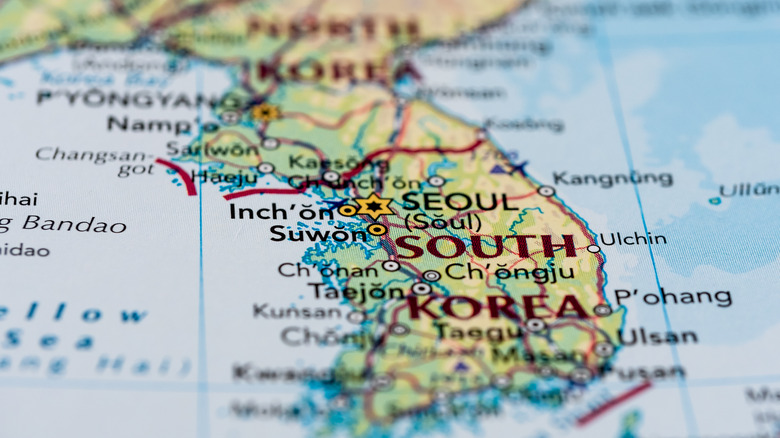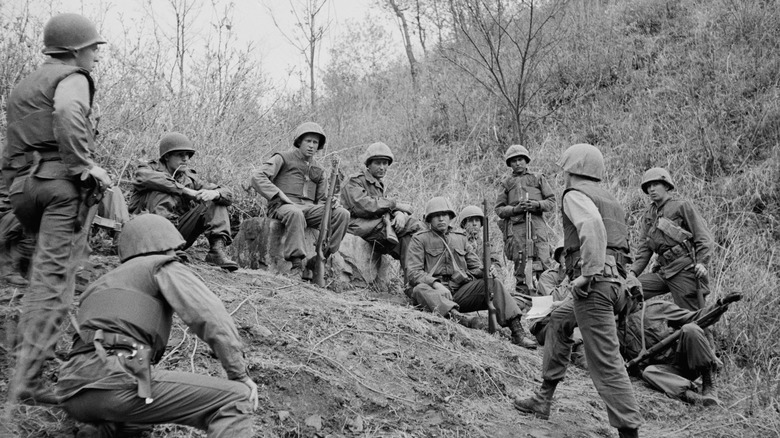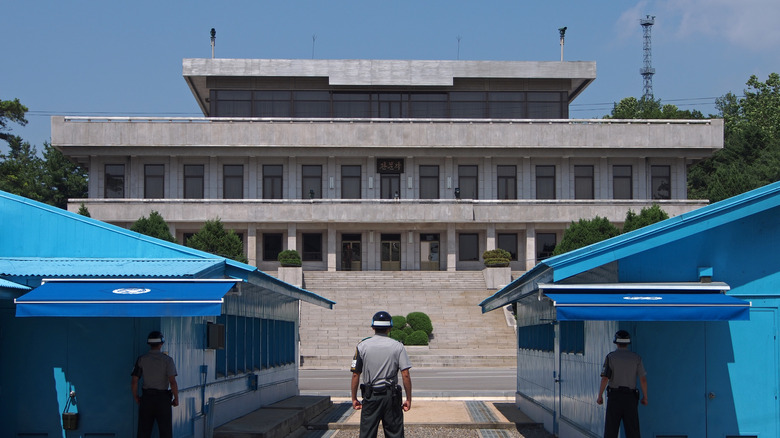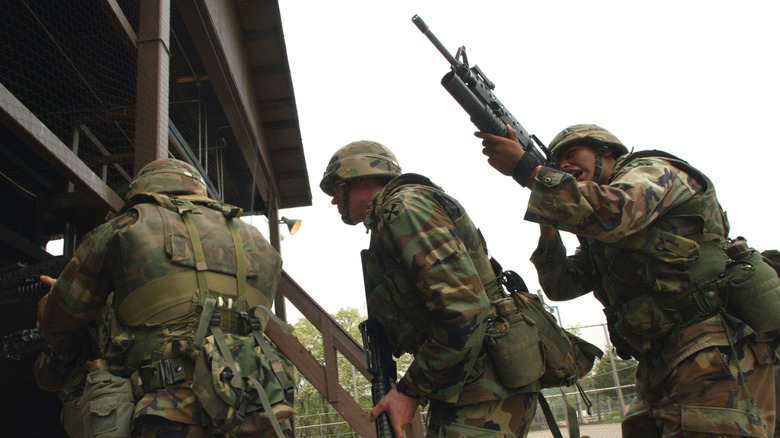The Bizarre Truth Behind The World's Most Dangerous Golf Course
Golf can be a relaxing sport. It's played in the serene confines of nature, and being quiet is one of golf's greatest unwritten rules. So it certainly seems odd that there would be a place to play such a relaxing game in one of the most tense places on Earth.
The DMZ — which stands for Demilitarized Zone — is the thin strip of land that's around 150 miles long that separates the Korean peninsula into North and South Korea. While it is, as the name indicates, demilitarized, the land just outside of it is not. In fact, it's heavily militarized, and has been that way for over 70 years (via Britannica).
According to Golf, Camp Bonifas sits just 500 yards from the DMZ, which would explain why a nearby sign warns golfers not to retrieve balls that were shanked out of bounds for fear of land mines. For that reason, it has claimed the title of the world's most dangerous golf course.
The divided Korean Peninsula
According to History, during World War II, the Korean Peninsula was controlled by the Japanese empire. By the time the war was over and the Japanse had been defeated, the United States and the Soviet Union gained control of the peninsula. Much like they did in Germany, where the country was divided into halves, with each taking control of one, the Korean Peninsula was divided along the 38th parallel. The Soviets took the northern half, which became North Korea, and the United States took the southern half, South Korea.
As was the case for a large portion of the 20th century, the two halves of the Korean Peninsula represented the two warring political ideologies of the day, with North Korea adopting communism. Meanwhile, in South Korea, an anti-communist dictator named Syngman Rhee came into power, and received the United States' backing, even if they did so reluctantly.
The Korean War
On June 25, 1950, North Korean soldiers crossed the 38th parallel into South Korea, effectively starting the Korean War. It was the first military action of the Cold War between the United States and the Soviet Union, and U.S. forces quickly joined the fray on behalf of South Korea.
Both sides exchanged salvos from their respective sides of the 38th parallel, but as the war seemed to stall with neither seeing much advancement, it was determined that some kind of peace agreement needed to be made. Otherwise, there was a risk that within a decade after World War II, World War III would be inevitable
According to Britannica, an agreement was reached in 1953 that kept the 38th parallel as the dividing line between the two halves of the Korean peninsula. In addition to this, an additional 1.2 miles — about 2 kilometers — from the 38th parallel into both countries was declared the Demilitarized Zone. The 150 mile-long, 2.4 mile-wide DMZ is still in place today. Inside of it is where officials from each side occasionally meet.
Tensions still run high today
Things between North and South Korea never really cooled off in the years since the Korean War came to an end. For this reason, there's still a heavy military presence on each nation's side of the DMZ. According to Reuters, the United States and South Korea struck a deal in 1966 that determined which country was responsible pay for different aspects of maintaining a U.S. military presence on the Korean peninsula. In 2021, a new deal was reached that saw South Korea footing a larger portion of the bill than they had in the previous agreement.
Troops stationed along the DMZ need some way to blow off steam and something to serve as a distraction from the ever-present threat of war, and that's where Camp Bonifas' golf course — actually, it's a single hole — comes into play. According to The Atlantic, the camp where the most dangerous golf course in the world is located takes its name from one of the victims of a grisly murder that happened in 1976
Camp Bonifas is named after Captain Arthur Bonifas
The camp where the hole is located is named after Captain Arthur Bonifas who was the victim of a horrific murder in 1976, yet another reason why this is deserved candidate for the "most dangerous golf course in the world" title. According to The Atlantic, it all started with a simple task that given the circumstances, wouldn't have been so simple. Bonifas and First Lieutenant Mark Barrett led a team of security guards and laborers intent on trimming a large, 40-foot-tall poplar tree.
While Bonifas was in the midst of trimming the tree, a North Korean lieutenant yelled at them to stop, but the Americans ignored him and continued trimming the tree. Soon more North Korean troops arrived, but again, Bonifas just blew them off. The North Koreans rolled up their sleeves and beat then beat Bonifas to death with crowbars, pipes, clubs, and axes, then chased down Barrett and did the same to him.
The golf course at Camp Bonifas
There are some important details to know on the off chance you find yourself playing a quick round of golf — and given it's a single par-3 hole, per ESPN — at Camp Bonifas.
The hole sits just a few hundred yards from the demilitarized zone, meaning one sliced tee shot can mean an international incident. Once again fitting with the military and danger aesthetics, it makes sense that the hole's tee box itself would be perched atop an empty machine gun nest. The hole is made up of artificial turf, according to Golf, and that is just one of the non-military-related factors that make the hole difficult to play. The 192-yard hole is prone to gusts of wind coming from North Korea and has a hard green that tends to let shots bounce right off of it.
However, this isn't the only golf course on a military installation in South Korea. Camp Casey, which sits 40 miles north of the South Korean capital of Seoul, features a nine-hole course that's a little bit cushier than what's found at Camp Bonifas. Camp Casey also has fast-food restaurants and a movie theater.





